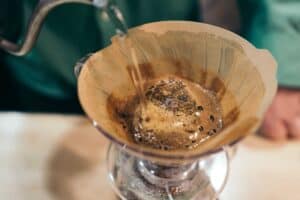Which Coffee is Naturally Low in Acid?

Coffee is one of the world’s most popular drinks. Much like fine wine, it comes in a wide variety of forms! However, just because many people love that familiar coffee taste, it doesn’t necessarily mean that it is good for everyone to drink in large quantities.
Like most health-related concerns, everything is fine in moderation. Coffee is actually a relatively acidic drink, especially when taken black (without any milk or cream). That said, there are a number of benefits to drinking decaf coffee, on top of the lower levels of acid.
Most coffee varieties sit between 4.5 and 5 PH, which may not sound particularly acidic on the face of it when compared to fruit juices for example. However, for a drink that doesn’t necessarily taste particularly acidic and that millions of people drink multiple servings every morning, it shouldn’t be underestimated.
Many people actually suffer from a number of different health problems as a result of consuming too much acid in their diet. These range from digestive issues to heartburn. However, the most common complication is acid reflux.
But, the question still remains, are there any low-acid coffees out there that even acid reflux sufferers can enjoy? Well, let’s find out!
What is Wrong with Acidic Food and Drinks?
As per this article by WebMD, the body’s natural PH level sits at 7.4. Ensuring your body’s acid levels remain relatively stable can help maintain sound biological functioning of the blood, stomach, and bones.
Although there is nothing inherently wrong with eating high-acid foods and drinks as part of a healthy, balanced diet, consuming highly acidic foods too often can lead to health complications.
If you consume too much acid in your diet, you may suffer from symptoms such as:
- Acid Reflux
- Heartburn
- Kidney Stones
- Tooth Decay
- Stomach Cramps.
Some of the most acidic foods and drinks include:
- Processed Meat
- Beans
- Eggs
- Salt.
Is Coffee Acidic?
Coffee registers at between 4.5 and 5 PH, which is more acidic than regular water, (7 PH), but not as acidic as orange juice (3 PH).
Whilst it is not necessarily the most acidic drink in the world, the volume at which it is consumed means it can definitely impact your health. This is especially true if you are particularly susceptible to acid-induced health issues.
However, the acidity of your coffee is impacted by the brewing method, grind size of beans, roast profile, brew time, and additional ingredients.
How to Reduce the Acidity of Coffee?
There are actually quite a few different ways to reduce the acidity in your cup of coffee. Try a combination of these and see if they make a difference!
- Opt for a Dark Roast:
There is less citrus flavor in dark roast coffee, meaning the stomach produces less acid when breaking it down.
- Longer Brew Time:
Acidic coffee can sometimes be a symptom of under-brewed grounds. This is due to the hot water not dissolving enough of the caffeine or acidic flavor compounds away. The remedy for this is to ensure your coffee is brewed for a sufficient amount of time for the particular brewing method you are using. Be careful though, if you brew it for too long it could taste bitter!
- Use Low Acid Coffee Beans:
Using coffee beans that are either naturally low in acid or have been treated to remove some of the acid from them is a sure fire way to reduce the acidity of your brew. As coffee lovers have become more and more health conscious, big names in the industry have started to appeal to consumer wants and needs, particularly from a health and wellness point of view.
There is a growing market for low-acid coffee beans. Naturally low-acid coffee bean varieties include Excelsa and Racemosa beans.
Coffee beans may also be roasted over a long period of time or decaffeinated to lower the acid content.
- Add Milk or Milk Substances:
Adding milk or creamer will help to reduce the overall acidity of your cup of coffee. Since milk and cream are much closer to a PH of 7, adding them to your cup of coffee will not only take out some of the bitterness to the taste, but it will also reduce the acid content.
- Explore Cold Brewing:
Another way to reduce the overall acidity of your cup of joe. Cold brew coffee is a little different from the popular iced coffee, as the coffee grounds are actually steeped in cold water and coffee is extracted over a 12-24 hour period.
Serving cold brew rather than hot brewed coffee can be more than half the acidic content of the coffee itself, due to the more gradual rate of extraction.
Which Coffees are Naturally Low in Acid?
The acidity in your cup of coffee will of course depend on how the coffee is brewed, as discussed above.
Dark roasted coffee is of course naturally low in acid, but you can argue that this is actually a treatment process that affects the characteristics of the coffee beans.
Again, the same can be said for other slow-roasted coffee beans specifically treated to reduce the acid content, as well as decaf.
However, the only truly naturally low-acid coffee is the Racemosa bean. It is an incredibly rare and expensive bean that is found in the forest belt situated between Zimbabwe and Kwa-Zulu Natal in South Africa.
It has incredibly low levels of caffeine, less than half of what you’ll typically find in a regular arabica bean.
Best Low Acid Coffees
Here are some of the best low-acid coffee beans you can buy on the market today!
Pact Coffee Zaroca
Pact is becoming a more popular brand in the coffee world and for good reason. Their dark-roasted Zaroca coffee beans are naturally low in acid, making them a great alternative for those who suffer from acid reflux. Originating from Brazil, these bold, full-bodied beans have a chocolate flavor that is balanced out nicely with a hint of sweet apple that cuts through the natural earthiness of the dark, smokey beans.
Lifeboost Coffee
Many coffee brands claim to have health-boosting benefits, which can sometimes be overinflated as just high-quality beans. However, Lifeboost offers some of the best, naturally sourced, low-acid coffee beans money can buy! Lifeboost coffee comes in light, medium, and dark roast, but for the lowest acid levels, you are best off going for the dark. They are farmed in practically untouched soil in the highlands of Nicaragua and feature nutty and smokey-tasting notes.
Low-Acid Coffee Blend (Volcanica Coffee)
As the name would suggest, Low-Acid Coffee by Volcanica is a great option for those looking for a more neutral bean. Whilst this is a medium roast coffee since it grows in volcanic, mineral-rich soil, these are naturally high quality, nutrient-dense, and low acid beans. You still get that familiar nuttiness and fruity undertones that let the personality of the coffee shine through here, without the overbearing smokiness of a dark roast that can sometimes compromise flavor.
Summary
Overall, there are a number of reasons why a coffee lover may want to seek out low-acid coffee. These range from suffering from acid reflux, to stomach problems, to wanting to avoid tooth decay.
Luckily, there are now many high-quality, specialty coffee brands that offer coffee beans that are either treated or naturally low in acid. There are a number of things you can do to reduce the level of acidity in your cup of coffee, from using milk or milk alternatives to trying cold brew.
Coffee Acidity Frequently Asked Questions
Racemosa coffee beans are naturally low in both acid and caffeine. These are extremely rare and expensive, however. Fortunately, there are now many decaf coffee beans that use natural methods such as the Swiss Water Process which removes caffeine by dissolving it away in hot water, without the use of chemicals.
Yes, darker roasted coffee tends to be less acidic as more of the acidic compounds leave the coffee beans during the roasting process.
In order to make your coffee less acidic, add milk, use darker roasted or decaffeinated coffee beans, or brew for a shorter period of time. Longer brew methods like French Press and drip brewed pour over coffee tend to be more acidic than shorter brew methods like Aeropress and espresso.
That being said, cold brew coffee is not very acidic, due to it’s long brew time in cold water specifically.



